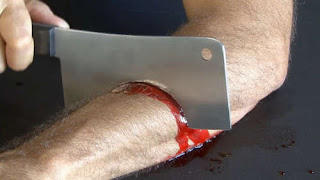Bayangkan seseorang yang terputus pergelangan tangannya akibat terkena mesin pemotong tetapi individu itu hanya meraung kesakitan tetapi masih relaks selepas beberapa ketika kerana dia diberi cuti rehat untuk membolehkan anggotanya yang terputus itu tumbuh semula seperti sediakala.
Begitulah gambaran yang diberikan oleh penemuan baru saintis dalam membuat kajian tentang penumbuhan semula anggota badan haiwan jenis amphibia.
Walaupun penemuan masih di peringkat kajian terhadap tikus, namun ia merupakan sesuatu yang menjanjikan kemungkinan amat tinggi terhadap manusia.
Makin lama, makin berbagai penemuan pelik-pelik yang manusia temui. Teringat saya dengan perbincangan bersama beberapa kawan-kawan baru-baru ini tentang kejadian-kejadian pelik. Ustaz Izham menceritakan tafsir Imam Sayuthi terhadap tanda-tanda kiamat iaitu keluarnya benda-benda pelik dari perut bumi.
Yang dimaksudkan dengan benda-benda pelik itu adalah seumpama perkara-perkara seperti di atas iaitu penemuan teknologi-teknologi baru yang tiada pada suatu ketika dahulu. Contoh lain adalah seperti internet, telefon bimbit, kenderaan-kenderaan berbagai rupa dan jenis dan lain-lain lagi. Wallahu'alam.
Baca penemuan baru di bawah untuk keterangan lanjut;
Humans could regrow body parts like some amphibians
Regrowing amputated limbs, broken backs and even damaged brains could one day be a reality after scientists discovered a gene that is key to the almost magical ability.
Researchers have found that the gene p21 appears to block the healing power still enjoyed by some creatures including amphibians but lost through evolution to all other animals.
By turning off p21, the process can be miraculously switched back on.
Academics from The Wistar Institute in Philadelphia found that mice lacking the p21 gene gain the ability to regenerate lost or damaged tissue.
Unlike typical mammals, which heal wounds by forming a scar, these mice begin by forming a blastema, a structure associated with rapid cell growth.
According to the Wistar researchers, the loss of p21 causes the cells of these mice to behave more like regenerating embryonic stem cells rather than adult mammalian cells. This means they act as if they creating rather thane mending the body.
Their findings, published in the Proceedings of the National Academy of Sciences, provide solid evidence to link tissue regeneration to the control of cell division.
They turned off the gene in mice which had damaged ears and they regrew them. While they say it is early days, there is nothing theoretically different about applying the same process to humans.
Professor Ellen Heber-Katz, the lead scientist, said: "Much like a newt that has lost a limb, these mice will replace missing or damaged tissue with healthy tissue that lacks any sign of scarring.
"While we are just beginning to understand the repercussions of these findings, perhaps, one day we'll be able to accelerate healing in humans by temporarily inactivating the p21 gene.
"In normal cells, p21 acts like a brake to block cell cycle progression in the event of DNA damage, preventing the cells from dividing and potentially becoming cancerous.
"We propose that any future therapy would involve turning off p21 transiently during the healing process and only locally at the wound site. This might be done through locally applied drugs. This should minimise any side effects."


No comments:
Post a Comment
Segala komen pembaca amat dihargai, tapi mohon komen dengan berhemah ya ! Terima Kasih !